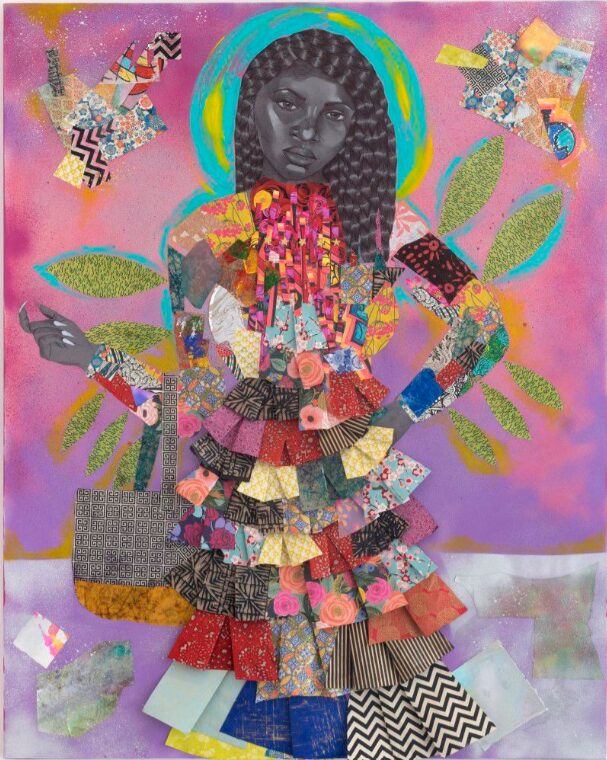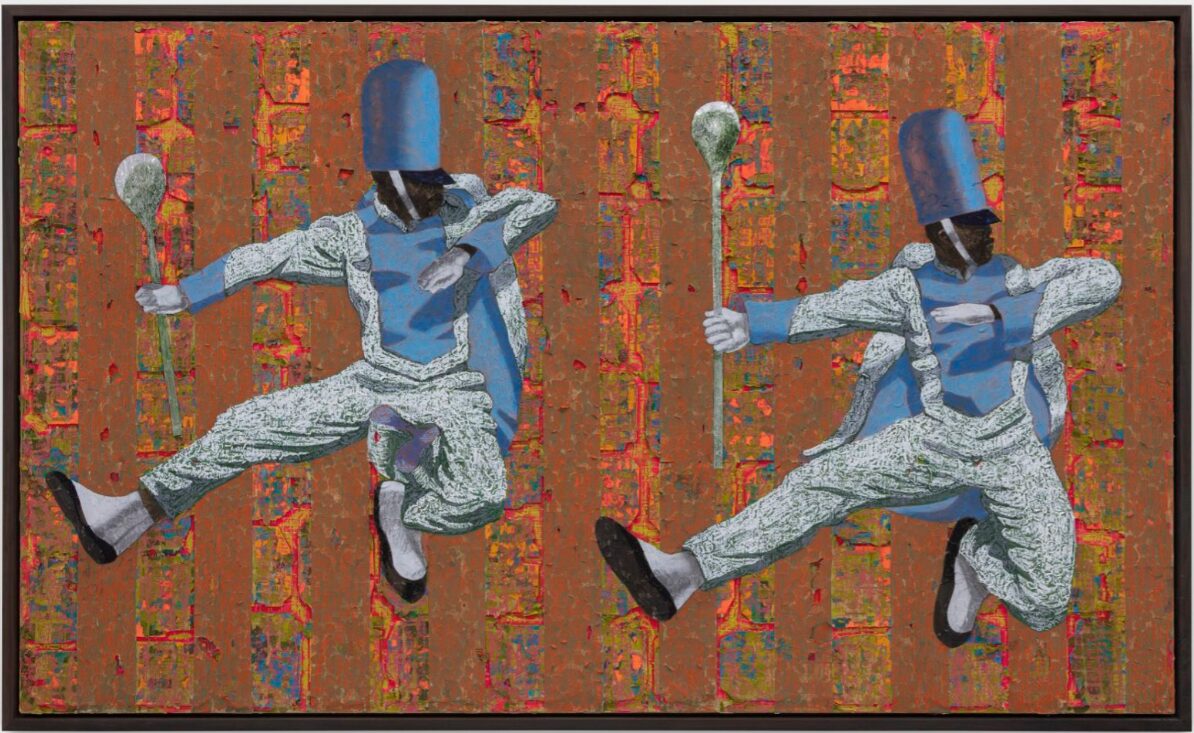The Museum of Fine Arts, Houston is currently home to a unique exhibit that’s changing the narrative of how we explore the rich and diverse experiences of black culture in America. Multiplicity: Blackness in Contemporary American Collage is the first of its kind, displaying the work of 52 living artists who have created dynamic, thought-provoking pieces that challenge traditional notions of race and representation in black culture. The massive display was originally introduced at Frist Art Museum’s gallery in Nashville Tennessee. Frist describes the exhibit as a deep dive into various aspects of black identity.
“Multiplicity explores the varying ways collage is employed and how the technique suggests diverse conceptual concerns such as cultural hybridity, notions of beauty, gender fluidity, and historical memory. By assembling pieces of paper, photographs, fabric, and salvaged or repurposed materials, these artists create unified compositions that express the endless possibilities of Black-constructed narratives despite our fragmented society.”

The style of collage calls for a blending of different artistic mediums and disciplines using a combination of various materials such as photographs, fabric, painting, drawing, sculpture, even repurposed materials to create an accumulation of ideas, emotions and stories. Its ability to engage with the complexities of our digital age, blend different artistic traditions, and serve as a vehicle for political and social commentary make it a valuable tool for artists seeking to explore new ideas and perspectives. By combining elements, artists are able to push the boundaries of traditional art forms and create work that is multi-dimensional and dynamic. Collage has been a prominent technique in art for centuries, but it has gained a new level of popularity and significance in contemporary art. From its humble beginnings as a tool for experimentation and innovation in the early 20th century, collage has evolved into a widely utilized medium that has been embraced by artists across various genres and styles. One of the key reasons for the resurgence of collage in contemporary art is its ability to echo the black experience with new meanings and narratives that reflect the chaotic and “fragmented” nature of perceived existence. This interdisciplinary approach not only bends the traditional conventional notions of artistic practice but also opens new possibilities for experimentation. One of the exhibits artists, Yashua Klos, describes how the project expands his ability to communicate through art.
“Collage was really an answer to my quest for rendering form, which for me is always about presence and representation. I discovered it as a remedy for what I thought was the flat graphic nature of wood block printing. Collage gave me the opportunity to cut up my prints then reassemble them into an image that announced itself to have more form than the flat direct print could on its own.”
By incorporating a variety of elements into their work, these artists represent symbolic images of black experiences. Dereck Fordjour spoke on how the use of collage helped him find a unique way to express his artistic visions. “The surfaces are accumulated over time. It takes about two to three weeks to make a surface before I start. That process is adhering layers. There’s literally a derma, epidermis approach to building layers; then when I do work on the top, I often cut away and excavate layers. I can peel tear and expose the subterranean layers, that’s really important to me.”
Tschabalala Self from Harlem, New York is a contemporary American artist known for her bold and vibrant depictions of the Black female body. Self creates visually striking works that delve into the perspectives and complexity of Black womanhood. Her work often explores themes of identity, sexuality, and empowerment. Popular pieces and many places featured.
In an interview with Frist Art Gallery, Self spoke on how her thought-provoking and visually engaging pieces purposely disrupt and subvert dominant narratives about blackness.
“Sometimes, for some to be whole, it actually has to not be fully understood. There has to be a level of nonsense for it to be real. It can’t be fully articulated, i embed a bit of mystery into all my work. The paintings are completed by the viewers.”
Through her use of multiple layers and textures, the diversity and richness of experiences with unapologetic confidence in its details. Self’s innovative commitment to celebrating the beauty and complexity of Black bodies have earned her critical acclaim in the art world, making her a rising star in the contemporary art scene.

“It’s been a way to engage in self-exploration. When I watch tv shows, movies, etcetera I felt there were always images missing. (Black women) were missing a layer, missing authenticity, incomplete. Doing my own paintings, I’m allowed to make these characters feel more whole, more layered.”
With a solid background in fun arts and graphic design, Lanecia Rouse, often combined traditional techniques for influences to create stunning pieces that resonate with viewers on a deep level. incorporating elements of history, culture, storytelling, and personal experiences in her art. Rouse’s pieces are often described as bold and dynamic, capturing the essence of her ideas and subjects in a way that is both visually stunning and emotionally evocative. Although Rouse uses collage often in her own time, this exhibit gave her the liberty to create new and empowering representations of black identity for a new audience.
“I was really curious about the play of taking these fragments, these pieces that seemingly didn’t fit together and finding ways to bring harmony and beauty with these pieces.”
Lanecia’s commitment to authenticity has kept audiences engaged with their creations for many years. Organizing the various sources needed for multiplicities project was an adventure she regularly enjoys when preparing for a collage piece. “I will spend sometimes two weeks just doing image sourcing then i will begin to play with paint and paper ion the canvas. Its like a call-and-response, I grew up in the church with that. Like, what is this surface calling, what kind of movement, what kind of body, what kind of story is this surface calling for? Then i respond with imagery.”
In a world flooded with images, information, and media, artists have turned to collage as a means of dissecting, re-contextualizing, and reinterpreting the visual landscape. The artists of Multiplicity celebrate the strength and resilience of black individuals, while also acknowledging the struggles and challenges they have faced through pure innovative creativity. Their pieces provoke thought, spark conversation, and inspire change. Collage in contemporary art is a versatile and dynamic medium that continues to evolve and adapt to the changing landscape of artistic practice. offering alternative perspectives and challenging viewers to reconsider their assumptions and beliefs. Each piece simultaneously expresses a relatable experience while also reshaping the way we see and understand the Black experience. The exhibit embraces the depth of black identity, highlights innovative artists, nurtures black imagery, and opens dialogue that connects art and society.

Multiplicity: Blackness in Contemporary American Collage will be at the Museum of Fine Arts, Houston until May 12, 2024 followed by The Phillips Collection in Washington, DC in July.
Caroline Wiess Law Building, 1001 Bissonnet St. Houston, TX 77005
*Cover Art: Derek Fordjour, Airborne Double, 2022








